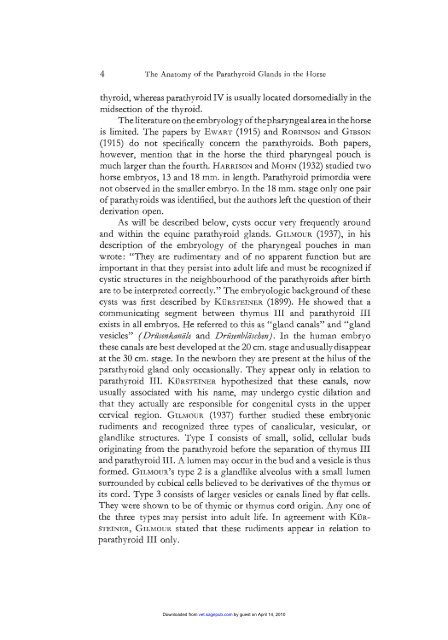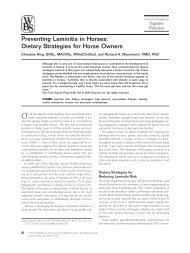Nutritional Secondary Hyperparathyroidism in the Horse
Nutritional Secondary Hyperparathyroidism in the Horse
Nutritional Secondary Hyperparathyroidism in the Horse
You also want an ePaper? Increase the reach of your titles
YUMPU automatically turns print PDFs into web optimized ePapers that Google loves.
4 ‘The Anatomy of <strong>the</strong> Parathyroid Glands <strong>in</strong> <strong>the</strong> <strong>Horse</strong><br />
thyroid, whereas parathyroid IV is usually located dorsomedially <strong>in</strong> <strong>the</strong><br />
midsection of <strong>the</strong> thyroid.<br />
The literature on <strong>the</strong> embryology of <strong>the</strong> pharyngeal area <strong>in</strong> <strong>the</strong> horse<br />
is limited. The papers by EWART (1915) and ROBINSON and GIBSON<br />
(1915) do not specifically concern <strong>the</strong> parathyroids. Both papers,<br />
however, mention that <strong>in</strong> <strong>the</strong> horse <strong>the</strong> third pharyngeal pouch is<br />
much larger than <strong>the</strong> fourth. HARRISON and MOHN (1932) studied two<br />
horse embryos, 13 and 18 mm. <strong>in</strong> length. Parathyroid primordia were<br />
not observed <strong>in</strong> <strong>the</strong> smaller embryo. In <strong>the</strong> 18 mm. stage only one pair<br />
of parathyroids was identified, but <strong>the</strong> authors left <strong>the</strong> question of <strong>the</strong>ir<br />
derivation open.<br />
As will be described below, cysts occur very frequently around<br />
and with<strong>in</strong> <strong>the</strong> equ<strong>in</strong>e parathyroid glands. GILMOUR (1937), <strong>in</strong> his<br />
description of <strong>the</strong> embryology of <strong>the</strong> pharyngeal pouches <strong>in</strong> man<br />
wrote: “They are rudimentary and of no apparent function but are<br />
important <strong>in</strong> that <strong>the</strong>y persist <strong>in</strong>to adult life and must be recognized if<br />
cystic structures <strong>in</strong> <strong>the</strong> neighbourhood of <strong>the</strong> parathyroids after birth<br />
are to be <strong>in</strong>terpreted correctly.” The embryologic background of <strong>the</strong>se<br />
cysts was first described by ~(URSTEINER (1899). He showed that a<br />
communicat<strong>in</strong>g segment between thymus I11 and parathyroid I11<br />
exists <strong>in</strong> all embryos. He referred to this as “gland canals” and “gland<br />
vesicles” (Driisenkade and Driiserzbla.rcben). In <strong>the</strong> human embryo<br />
<strong>the</strong>se canals are best developed at <strong>the</strong> 20 cm. stage andusuallydisappear<br />
at <strong>the</strong> 30 cm. stage. In <strong>the</strong> newborn <strong>the</strong>y are present at <strong>the</strong> hilus of <strong>the</strong><br />
parathyroid gland only occasionally. They appear only <strong>in</strong> relation to<br />
parathyroid 111. ~(URSTEINER hypo<strong>the</strong>sized that <strong>the</strong>se canals, now<br />
usually associated with his name, may undergo cystic dilation and<br />
that <strong>the</strong>y actually are responsible for congenital cysts <strong>in</strong> <strong>the</strong> upper<br />
cervical region. GILMOUR (1937) fur<strong>the</strong>r studied <strong>the</strong>se embryonic<br />
rudiments and recognized three types of canalicular, vesicular, or<br />
glandlike structures. Type I consists of small, solid, cellular buds<br />
orig<strong>in</strong>at<strong>in</strong>g from <strong>the</strong> parathyroid before <strong>the</strong> separation of thymus I11<br />
and parathyroid 111. A lumen may occur <strong>in</strong> <strong>the</strong> bud and a vesicle is thus<br />
formed. GILMOUR’S type 2 is a glandlike alveolus with a small lumen<br />
surrounded by cubical cells believed to be derivatives of <strong>the</strong> thymus or<br />
its cord. Type 3 consists of larger vesicles or canals l<strong>in</strong>ed by flat cells.<br />
They were shown to be of thymic or thymus cord orig<strong>in</strong>. Any one of<br />
<strong>the</strong> three types may persist <strong>in</strong>to adult life. In agreement with KUR-<br />
STEINER, GILMOUK stated that <strong>the</strong>se rudiments appear <strong>in</strong> relation to<br />
parathyroid I11 only.<br />
Downloaded from<br />
vet.sagepub.com by guest on April 14, 2010



